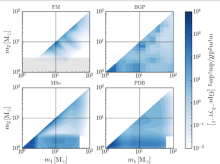
Abstract
We report on the population properties of 76 compact binary mergers detected with gravitational waves below a false alarm rate of 1 per year through GWTC-3. The catalog contains three classes of binary mergers: BBH, BNS, and NSBH mergers. We infer the BNS merger rate to be between 13 Gpc−3yr−1 and 1900 Gpc−3yr−1 and the NSBH merger rate to be between 7.4 Gpc−3yr−1 and 320 Gpc−3yr−1 , assuming a constant rate density versus comoving volume and taking the union of 90% credible intervals for methods used in this work. Accounting for the BBH merger rate to evolve with redshift, we find the BBH merger rate to be between 17.3 Gpc−3yr−1 and 45 Gpc−3yr−1 at a fiducial redshift (z=0.2). We obtain a broad neutron star mass distribution extending from 1.2+0.1−0.2M⊙ to 2.0+0.3−0.2M⊙. We can confidently identify a rapid decrease in merger rate versus component mass between neutron star-like masses and black-hole-like masses, but there is no evidence that the merger rate increases again before 10 M⊙. We also find the BBH mass distribution has localized over- and under-densities relative to a power law distribution. While we continue to find the mass distribution of a binary's more massive component strongly decreases as a function of primary mass, we observe no evidence of a strongly suppressed merger rate above ∼60M⊙. The rate of BBH mergers is observed to increase with redshift at a rate proportional to (1+z)κ with κ=2.7+1.8−1.9 for z≲1. Observed black hole spins are small, with half of spin magnitudes below χi≃0.26. We observe evidence of negative aligned spins in the population, and an increase in spin magnitude for systems with more unequal mass ratio.